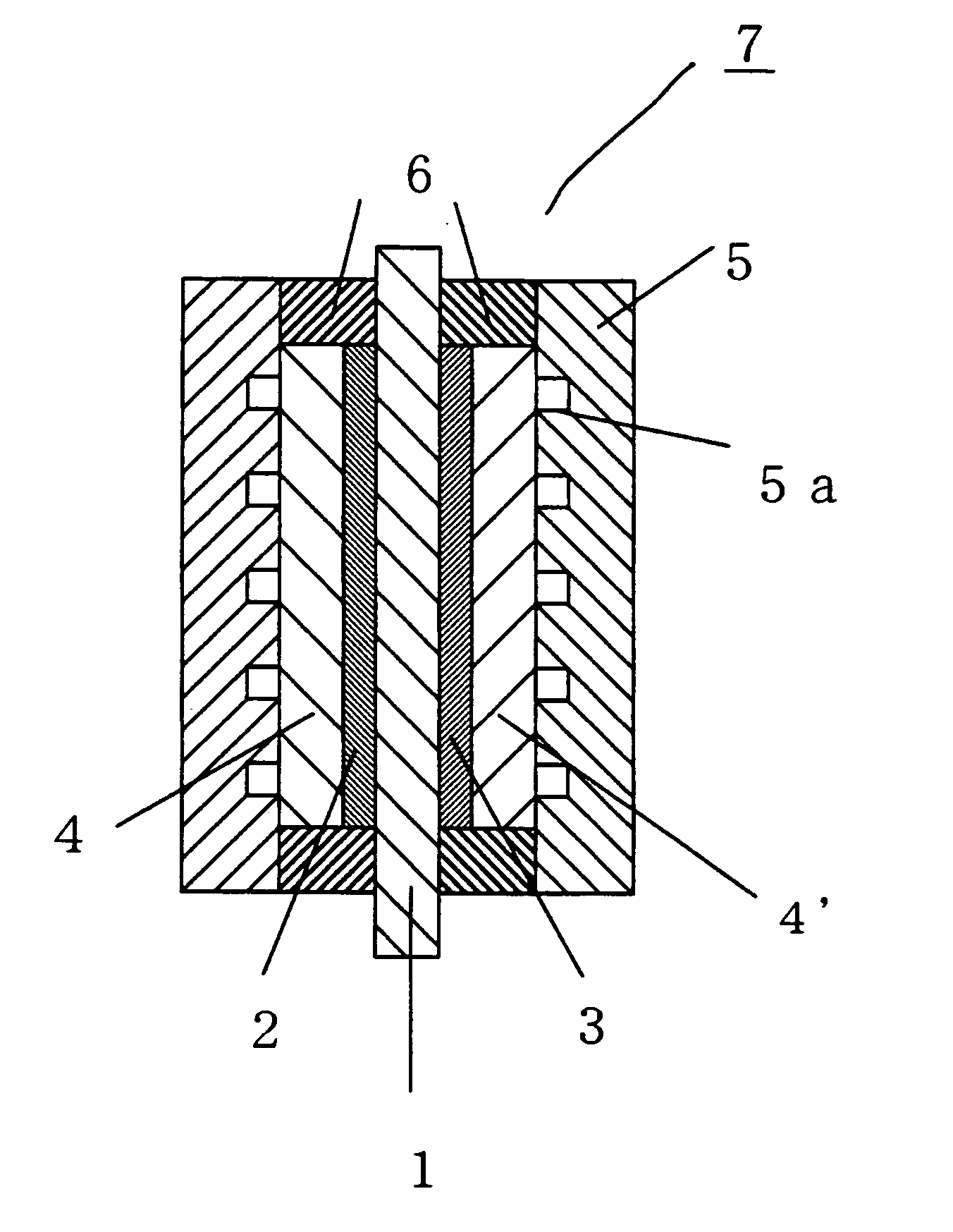Membrane-electrode assembly for polymer electrolyte fuel cell, and process for its production
a technology of electrolyte fuel cell and membrane electrode, which is applied in the direction of cell components, final product manufacturing, sustainable manufacturing/processing, etc., can solve the problems of poor stability against radicals, poor energy efficiency, and poor durability of electrolyte membrane, and achieve excellent durability and high energy efficiency. , the effect of high power generation performan
- Summary
- Abstract
- Description
- Claims
- Application Information
AI Technical Summary
Benefits of technology
Problems solved by technology
Method used
Image
Examples
example 1
Present Invention
[0036] 2.5 g of a catalyst having platinum dispersed on carbon support (specific surface area: 800 m2 / g) in an amount of 50% based on the total mass of the catalyst (manufactured by N.E. Chemcat Corporation, hereinafter referred to as catalyst 1) was subjected to heat treatment at 800° C. for one hour in an argon atmosphere.
[0037] Then, 10.2 g of distilled water was added to 2.0 g of this heat-treated catalyst powder. Further, to this slurry, 11.2 g of a liquid having a CF2═CF2 / CF2═CFOCF2CF(CF3)O(CF2)2SO3H copolymer (ion exchange capacity: 1.1 meq / g dry polymer, hereinafter referred to as copolymer A) dispersed in ethanol and having a solid content concentration of 9 mass % (hereinafter referred to as an ethanol dispersion of copolymer A) was added. This slurry was homogenized by using a homogenizer (Polytron, tradename, manufactured by Kinematica Company) to obtain a coating fluid (a) for forming a catalyst layer.
[0038] This coating fluid a was applied by a bar ...
example 2
COMPARATIVE EXAMPLE
[0042] A coating fluid (b) for forming a catalyst layer was prepared in the same manner as in Example 1 except that the same catalyst 1 as in Example 1 was used as it is without being subjected to heat treatment. A catalyst layer (b) was prepared in the same manner as in Example 1 by using the coating fluid (b) instead of the coating fluid (a). The amount of platinum per unit area contained in the catalyst layer (b) was measured in the same manner as in Example 1 and was found to be 0.5 mg / cm2. Then, a membrane-catalyst layer assembly having an electrode area of 25 cm2 was prepared in the same manner as in Example 1 except that both anode catalyst layer and cathode catalyst layer were constituted by the catalyst layer (b).
[0043] Using this membrane-catalyst layer assembly, a membrane-electrode assembly was prepared in the same manner as in Example 1, and the initial cell voltages were measured by operation under the two conditions different in the dew point on t...
example 3
Present Invention
[0044] 5.0 g of the same catalyst 1 as in Example 1 was uniformly placed at the bottom of a 500 ml three necked separable flask equipped with a reflux condenser. The air in the flask was replaced with nitrogen gas, and then, 100 g of anhydrous ethanol was slowly added, whereupon ethoxylation treatment of acidic functional groups at the surface of the catalyst was carried out for 4 hours while ethanol was refluxed under heating. After completion of the treatment, the catalyst was separated by filtration and dried at 120° C. in a nitrogen atmosphere to take out a catalyst powder. To 2.0 g of the catalyst powder subjected to such ethanol treatment, 10.2 g of distilled water was added, and further, 11.2 g of a dispersion of copolymer A in ethanol was added. This mixed liquid was homogenized by means of a homogenizer (Polytron, tradename, manufactured by Kinematica Company) to obtain a coating fluid (c) for forming a catalyst layer.
[0045] A catalyst layer (c) was prepa...
PUM
| Property | Measurement | Unit |
|---|---|---|
| particle size | aaaaa | aaaaa |
| temperature | aaaaa | aaaaa |
| temperature | aaaaa | aaaaa |
Abstract
Description
Claims
Application Information
 Login to View More
Login to View More - R&D
- Intellectual Property
- Life Sciences
- Materials
- Tech Scout
- Unparalleled Data Quality
- Higher Quality Content
- 60% Fewer Hallucinations
Browse by: Latest US Patents, China's latest patents, Technical Efficacy Thesaurus, Application Domain, Technology Topic, Popular Technical Reports.
© 2025 PatSnap. All rights reserved.Legal|Privacy policy|Modern Slavery Act Transparency Statement|Sitemap|About US| Contact US: help@patsnap.com


